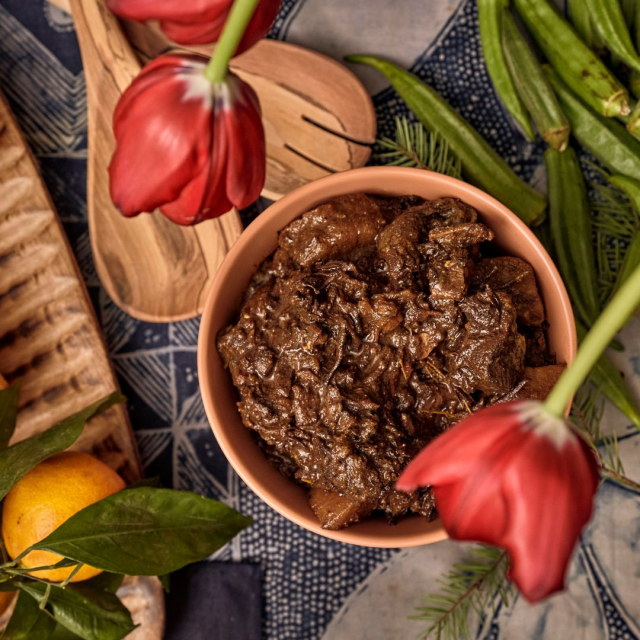Bull's tail is an emblematic dish of Spanish cuisine, especially appreciated in the south of the country. Its origin dates back to the time of bullfighting, where bull's tail was considered a valuable ingredient, and its preparation has been passed down from generation to generation. This stew is known for its intense flavour and tender texture, the result of slow and careful cooking.
Ingredients
To prepare a bull's tail for approximately four people, you will need the following ingredients:
1 kg of bull's tail (you can find it in specialized butcher shops)
2 large onions, chopped
2 carrots, sliced
1 green bell pepper, chopped
4 cloves garlic, minced
2 bay leaves
200 ml of red wine (preferably a Spanish wine)
500 ml of meat broth
Crushed tomatoes (approximately 400 g)
Flour (for coating)
Extra virgin olive oil
Salt and pepper to taste
Fresh parsley (for decoration)
Preparation
1. Prepare the tail
The first step in preparing the oxtail is to clean it properly. If the tail is not properly cleaned, you can ask the butcher to do it for you. Once cleaned, cut it into pieces of approximately 5 cm. Sprinkle with salt and pepper to taste.
2. Seal the Meat
In a large pot, heat a generous splash of extra virgin olive oil over medium-high heat. When the oil is hot, add the pieces of oxtail and brown them on all sides until they are well sealed. This step is crucial, as it will help to retain the juices of the meat and enhance the flavor of the stew. Once browned, remove the pieces of meat and set them aside on a plate.
3. Sauté the Vegetables
In the same pot where you browned the meat, add a little more oil if necessary. Add the onion, carrot and green pepper. Sauté over medium heat for about 10 minutes, or until the vegetables are tender and lightly browned. Then add the chopped garlic and cook for a couple more minutes, making sure it doesn't burn.
4. Add the Liquid Ingredients
Once the vegetables are ready, add the crushed tomatoes and mix well. Cook for about 5 minutes so that the tomato evaporates a little and the flavours intensify. Then, add the red wine and bay leaves. Let the wine evaporate for a few minutes.
5. Slow Cooking
Return the oxtail pieces to the pot and mix everything well. Next, add the beef broth, making sure the meat is well covered. Bring to a boil, then reduce the heat to low and cover the pot. Let simmer for about 2 to 3 hours. It's important to check the meat from time to time; it should be tender and shred easily with a fork.
6. Thicken the Sauce
Once the meat is ready, remove the pieces of oxtail from the pot and set them aside. If the sauce is too thin, you can thicken it by cooking it over medium heat uncovered for a few minutes. If you wish, you can puree some of the sauce with a blender to give it a smoother texture.
7. Serve
Place the pieces of oxtail on a deep plate and pour the sauce over them. Decorate with chopped fresh parsley. This dish can be accompanied with rice, mashed potatoes or bread to take advantage of the delicious sauce.
Tips for enjoying bull's tail
Pairing: Oxtail is best paired with a good Spanish red wine, such as a Rioja or Ribera del Duero. The acidity and body of the wine perfectly balance the flavors of the stew.
Make Ahead: This stew is often even more delicious the next day, as the flavors have time to meld. You can make it a day ahead and heat it up before serving.
Variations: Some recipes include peas or mushrooms to add more flavour and texture. You can also experiment with different spices such as sweet paprika or even a hint of cumin for an interesting twist.
Bull's tail has been a traditional dish in Spain for centuries. Its connection with bullfighting is undeniable; it is said that bullfighters consumed it as a way of honouring the bulls they had fought. Over time, this stew has evolved and adapted to different regions of Spain, being especially popular in Andalusia.
In many Andalusian cities, fairs and festivals are held where the oxtail is the star. Each chef has his own recipe and preparation style, making this dish as diverse as Spanish culture itself. Today, oxtail is not only enjoyed in homes, but also in fine dining restaurants that have elevated this dish to a gastronomic experience.
